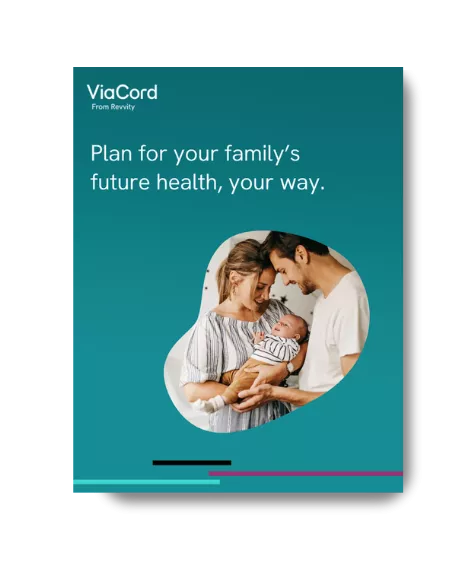Guest Blog

We want to give you a unique view of the people behind the science here at ViaCord. We sat down with our Director of Laboratory Services, Dr. Jonathan Carmichael (though he says his official title is Sara's husband, and Dad to Lochland and rescue pup Buddy from Miami) for a look behind the scenes.
Dr. Jonathan Carmichael joined ViaCord in August 2020 after spending 14 years in prenatal screening and diagnostics, focusing on pregnancy adverse events such as preeclampsia and fetal disorders. Dr. Carmichael received BSc Honors Biology with a focus in Biophysics from St. Francis Xavier University and a Ph.D. in Cell Biology from the University of Alberta. He holds the New York State Lab Director Certificate of Qualification in Fetal Defect Markers and Genetics: Molecular. He also has multiple peer-reviewed publications and book chapters under his belt. Dr. Carmichael isn't all science though, he plays the fiddle, piano, and guitar (though very poorly, he says). He enjoys mystery novels and spends as much time with his family as possible. We are super thankful to have him on board and glad we could sit down and ask him a few questions!
What brought you into this field?
I have been involved in prenatal screening and diagnostics for many years, both clinical and research and development. The opportunity to transition from purely disease identification to a field that enables the possibility for lifesaving treatments was one I could not pass on. ViaCord is actively working on expanding our screening test menu and engaging in significant Research and Development (R&D) efforts to broaden the use of cord blood and cord tissue in substantial ways. The combination of current state lifesaving uses of cord blood and future menu expansion made this job opportunity feel like I was a moth to a flame.
What were your goals when you started?
Our goals always remain the same - a high-quality product. From an R&D perspective, we want to expand the menu by offering services that one cannot find elsewhere in the field. Ultimately, we want to have a pipeline that consistently provides value to the customer, specifically actionable information and validated uses for cord blood and tissue.
What interests you in terms of current and future stem cell research?
The road to identify and validate treatment protocols is not an easy task. For example, there is a great deal of work being conducted with stem cells as a whole and the expansion of cell types thought to be important in regenerative applications. What interests me is the potential for cord blood and our processed cord tissue for use in additional family members such as grandparents. Think about the possibilities for research with the combination of genetic screening and cord blood and cord tissue banking. The intersection of these disciplines will drive scientific interest, thus bringing to light essential treatment options at the lab's clinical level and processing opportunities.
What can you tell us about the lab accreditations and certifications?
ViaCord is a CLIA certified, FDA registered, and AABB accredited lab. We have state-based certifications enabling ViaCord to collect and process samples derived from all over the USA. Our technicians and technologists enter the laboratory with exceptional credentials. On top of that, we add training, mentoring, annual performance evaluations, and reviews that enable us to provide consistent, reproducible, and quality results required for handling these precious specimens.
What are you doing to stay on top of new processing and preservation methods?
Our team of scientists and technicians continually review best practices and peer-reviewed publications and discuss how to optimize the process with key opinion leaders. Our five-compartment storage bag is one such example because it provides specimen integrity through multiple discreet storage segments, thus enabling the prospect for immediate and future use. We are also currently engaged in several processing-related research and development projects designed to improve the pre-preservation quality and acceptability of these units.
What is something you wish more people know about cord blood banking?
Cord blood banking is an investment in the health of your child and your family. Current uses are expanding from the donor child to siblings in areas such as Autism (ASD). Given the incidence of ASD and the potential for quantifiable improvement, this alone is a reasonable justification to bank cord blood and cord tissue stem cells. A simple search of proposed or ongoing clinical trials yields more than 250 endeavors for cord tissue alone. We are still at the beginning of understanding the uses of cord blood and cord tissue stem cells. Although science can move slowly, the potential for lifesaving or improvements in quality of life is actively being explored.
What would you like to see from stem cell research in your lifetime?
I would like to see the use of cord blood and cord tissue stem cells expand to a more significant number of disease states and recipients. With greater numbers of genetic tests occurring throughout the world, an understanding of the types and frequencies of diseases combined with research into cell or factor specific pathways (genes that ultimately affect pathways) as guided by genomics will expand the use of these units and will enable an accelerated path to the consumer.
What have you learned that has most surprised you in this field?
It is striking how underutilized cord blood and cord tissue stem cell banking is in the USA. With some 3.7 million births and ever-expanding research into uses for cord blood stem cells, cord tissue stem cells, and the expansion or isolation of cells from these units, only around 3% of units are stored. As reported by Nietfeld in 2008, the probability of undergoing autologous or allogeneic hematopoietic cell transplantation is greater as one ages. The use of cord blood and cord tissue stem cells could rise with greater collection and identified and validated treatment protocols.
Disclaimer: Banking cord blood does not guarantee that treatment will work, and only a doctor can determine when it can be used. PerkinElmer does not endorse or make recommendations with respect to research, medication, or treatments. All information presented is for informational purposes only and is not intended as medical advice.











